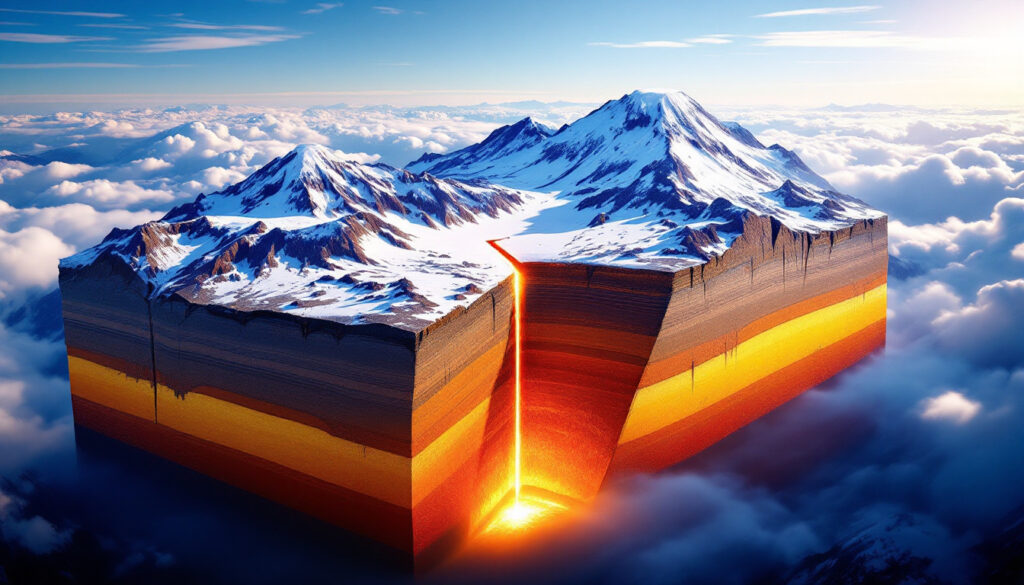What Are the Cascade Mountains and Why Should We Care About a "Broken Plate"?
The Cascade Mountains form a majestic north-south mountain range separating eastern and western Washington state—dividing the dry eastern region from the wetter western side. While most people recognize the iconic volcanic cones like Mount St. Helens and Mount Rainier that dot the range, few understand the complex geological story beneath these mountains.
The "broken plate" refers to an oceanic tectonic plate that fractured approximately 50 million years ago when North America collided with an oceanic island. This collision broke the plate and set the stage for the formation of the Cascade volcanic arc we see today. This geological detective story reveals how this ancient broken plate continues to influence the Pacific Northwest landscape.
How Did Scientists Discover the Broken Plate?
Modern geological research has revolutionized our understanding of the Cascades through three key advances:
-
Precise age dating techniques – Scientists can now determine the age of rocks with much greater precision than was possible a generation ago
-
Advanced geochemical analysis – More accessible and affordable instruments allow researchers to analyze the chemical composition of Cascade rocks in detail
-
Tomography imaging – Similar to medical CT scans, this technology allows geologists to "see" the broken plate deep within Earth's mantle
These technological advances have enabled geologists like Professor Jeff Tepper from the University of Puget Sound and his students to piece together evidence collected over 25 years of fieldwork. Their research has uncovered a geological story that was previously unknown, despite decades of study in the region.
New Research Methods Revealing Ancient Secrets
The discovery of the broken plate beneath the Cascades represents a significant shift in our understanding of plate tectonics. Traditional models assumed continuous subduction, but the evidence revealed by modern techniques shows that plate breakage and reorganization played a crucial role in the Cascades' formation.
Zircon geochronology has been particularly important, allowing scientists to narrow rock ages to within ±0.5 million years. This precision helped identify the critical 51-48 million year "breakoff belt" that marks where the oceanic plate fractured.
What is a Volcanic Arc and How Do the Cascades Fit This Model?
The Basic Subduction Zone Model
In the simplest geological model, the Cascade volcanic arc formed through a process called subduction. This occurs when:
-
A thin oceanic plate collides with a thicker continental plate
-
The denser oceanic plate sinks (subducts) beneath the continental plate
-
As the oceanic plate descends, it releases water into the mantle above
-
This water lowers the melting point of the mantle rock, generating magma
-
The magma rises through the continental crust, eventually reaching the surface as volcanoes
This process typically creates intermediate magmas with around 60% silica content, forming volcanic rocks called andesite at the surface and plutonic rocks called diorite when cooled underground.
Telltale Signs of Subduction Zone Magmas
Geologists identify subduction-related rocks through specific characteristics:
-
Hornblende minerals – These long, thin black minerals with distinctive 60° cleavage planes strongly indicate subduction-generated magmas
-
Mafic enclaves – These are dark blobs within lighter-colored granite that show fuzzy boundaries and evidence of fluid exchange between two different magmas
These features serve as geological fingerprints that help scientists distinguish subduction-zone magmas from those formed through other processes.
What Makes Washington's Geological Basement So Complex?
The foundation upon which the Cascade volcanoes formed isn't simple. Washington's geological basement consists of four distinct components:
-
Siletzia – An oceanic basalt terrane that was offshore before being added to Washington about 50 million years ago
-
Arkosic mélange – A complex mixture of rocks with an arkosic sandstone matrix containing enormous blocks of gabbro, schist, and limestone from across the Pacific Ocean
-
Crystalline core – Older metamorphic rocks that form much of the North Cascades
-
Swauk Formation – The only truly native local rock unit, consisting of arkosic sandstone deposited between 60-50 million years ago on a low, broad plain
This complex basement influenced how magmas would later rise through the crust. The mélange, in particular, played a crucial role in the story of the broken plate, as rising magmas had to navigate through this "dog's breakfast" of diverse rock types.
When Did the Cascade Volcanic Arc Begin and What Preceded It?
Two Distinct Geological Chapters
The geological history of the Cascades region includes two critical time periods:
-
51-48 million years ago – The "breakoff belt" period when the oceanic plate broke
-
46 million years ago to present – The Cascade volcanic arc period that continues today
Understanding the distinction between these periods is key to unraveling the broken plate mystery.
The Flat Washington Period (60-50 Million Years Ago)
Before either of these events, Washington was relatively flat with few mountains. During this time, the Swauk Formation (and its northern equivalent, the Chuckanut Formation) was deposited across a broad plain. This peaceful period would soon be disrupted by a major geological event.
How Did Siletzia Change the Pacific Northwest Forever?
The Oceanic Island That Transformed a Continent
Siletzia was a large oceanic island that formed rapidly off the coast of Northern California starting about 56 million years ago. As tectonic forces pushed this massive basaltic province toward North America, it eventually collided with the continent around 50 million years ago.
The collision had profound effects:
-
It crumpled and folded the previously flat Swauk and Chuckanut sandstones
-
It added significant new terrain to what would later become the Olympic Peninsula
-
Most importantly, it clogged the subduction trench and prevented the normal subduction process
This collision with Siletzia was the trigger that would ultimately break the oceanic plate beneath the Pacific Northwest.
What Evidence Reveals the Broken Plate Story?
The Breakoff Belt: A Linear Feature With Distinctive Magmas
One of the most compelling pieces of evidence for the broken plate is a linear belt of igneous rocks that runs through the Cascades. These rocks, dated between 51-48 million years ago, have several distinctive characteristics:
-
They are bimodal – consisting primarily of basalt and rhyolite with few intermediate compositions
-
They lack the characteristic tantalum-niobium depletion seen in subduction-related magmas
-
They form a linear pattern parallel to both the Siletzia suture and a feature called the Idaho slab curtain
Key locations where these breakoff belt magmas can be found include:
- Basalt of Summit Creek near White Pass
- Teanaway Formation near Blewett Pass
- Barlow Pass volcanics
- Bald Mountain pluton
- Mount Pilchuck stock
- Basalt of Discovery Creek in the Goat Rocks area (recently identified)
Geochemical Signatures Tell the Story
The geochemical analysis of these rocks reveals a critical distinction. When scientists plot the concentration of trace elements like barium, thorium, tantalum, and niobium:
- Arc magmas (46 million years to present) show a distinctive "valley" pattern with depleted tantalum and niobium
- Breakoff belt magmas (51-48 million years ago) lack this depletion pattern
This difference indicates that the breakoff belt magmas formed without a subducting slab beneath them—strong evidence for the broken plate hypothesis.
The Idaho Slab Curtain: The Missing Piece Found
Perhaps the most dramatic evidence comes from tomographic imaging that reveals a vertical slab of oceanic crust beneath Idaho—the "Idaho slab curtain." This feature represents the broken piece of the oceanic plate that has somehow migrated eastward and now hangs vertically beneath Idaho.
The parallel alignment of:
- The Siletzia suture
- The breakoff belt
- The Idaho slab curtain
Creates a compelling case that these features are all related to the same tectonic event.
How Did the Plate Break and What Happened Afterward?
The Breaking of the Farallon Plate
When Siletzia collided with North America around 50 million years ago, it clogged the subduction trench. The portion of the oceanic Farallon plate connected to Siletzia could no longer subduct normally, creating tension in the plate.
Eventually, this tension caused the plate to break. The weighted end of the broken piece began to sink and spin in the mantle, creating a gap beneath what would become the Cascade Mountains.
Decompression Melting: A Different Way to Make Magma
With the slab no longer present beneath the breakoff belt, hot mantle material could rise toward the surface where pressure was lower. This process, called decompression melting, generated magmas without the addition of water from a subducting slab.
This explains why the breakoff belt magmas have a bimodal composition (basalt and rhyolite) rather than the full spectrum of compositions seen in arc magmas. It also explains the absence of the tantalum-niobium depletion that characterizes subduction-related magmas.
The Rollback Effect and Age Progression
An additional fascinating aspect of this story involves igneous rocks in eastern Washington that show an age progression from northeast to southwest (52-46 million years ago). This progression has been interpreted as evidence of "rollback" as the broken plate began to sink and rotate.
This rollback effect created a sweeping pattern of magmatism that culminated near Wenatchee, Washington, just as the main Cascade volcanic arc was becoming established around 46 million years ago.
How Did the Cascade Volcanic Arc Finally Form?
Establishment of the Modern Subduction Zone
After the plate break and rollback events, a new subduction configuration was established around 46 million years ago. The remaining portion of the Farallon plate began subducting beneath North America in a more typical fashion, initiating the Cascade volcanic arc that continues to this day.
The earliest manifestations of this arc include:
- Goble Volcanics in southwestern Washington (approximately 41 million years ago)
- Northcraft Formation near Chehalis
- Tukwila Formation near Seattle
- Mount Persis near Index
These early arc magmas show the characteristic hornblende minerals and mafic enclaves that indicate subduction-related processes, as well as the distinctive tantalum-niobium depletion in their trace element patterns.
Why Does This Geological Detective Story Matter?
Understanding the broken plate beneath the Cascade Mountains provides crucial insights into:
-
How mountain ranges form – The story reveals complex processes beyond simple subduction
-
Regional geological hazards – Better understanding of the Cascades' formation improves our assessment of volcanic and earthquake risks
-
Earth's dynamic systems – The broken plate demonstrates how tectonic plates can behave in unexpected ways
-
Resource exploration – Many mineral exploration strategies are informed by understanding the geology of ore deposits associated with specific magmatic processes
This geological detective story also reminds us that even well-studied regions like the Cascades can still yield fundamental new discoveries when examined with fresh perspectives and new technologies.
How Can We See Evidence of This History Today?
Many locations throughout Washington state preserve evidence of this fascinating geological story:
-
White Pass area – The basalt of Summit Creek, where the breakoff belt was first identified
-
Teanaway region – Bimodal volcanic rocks, including basalt dikes and rhyolite domes, host Ellensburg blue agates
-
North Cascades Highway – Plutonic rocks showing the age progression from rollback
-
Isaquah Alps – Early Cascade arc magmas accessible near urban areas
-
Tamanous Rock – One of the earliest Cascade volcanic arc magmas near Port Townsend
These locations allow geologists and curious visitors to directly observe the evidence for this complex tectonic history.
What Questions Remain About the Broken Plate?
Despite the compelling evidence assembled, several questions remain for future research:
-
How far south does the breakoff belt extend into Oregon?
-
What precise mechanism caused the broken piece of plate to migrate eastward to its current position beneath Idaho?
-
How did the complex basement geology influence the composition of subsequent arc magmas?
-
What can the broken plate tell us about similar processes that might be occurring elsewhere on Earth?
These questions ensure that geological exploration of the Cascades will continue to yield new insights for generations to come.
Conclusion: A New Chapter in Cascade Mountain History
The discovery of the broken plate beneath the Cascade Mountains represents a significant advancement in our understanding of this iconic mountain range. By combining precise age dating, detailed geochemical analysis, and tomographic imaging, geologists have pieced together a compelling story of plate collision, breakage, and reorganization that set the stage for the volcanic landscape we see today.
This research demonstrates how geological processes that occurred millions of years ago continue to influence the landscape of the Pacific Northwest. Furthermore, it highlights connections between volcanic arcs and potential mineral deposits, including Carlin gold deposits and epithermal deposits that often form in similar tectonic settings. In addition, understanding these processes provides context for the formation of porphyry and IOCG deposits that can be economically significant.
The broken plate beneath the Cascades serves as a reminder that beneath even the most familiar landscapes lie complex and fascinating geological stories waiting to be discovered.
Disclaimer: The geological interpretations presented in this article represent the current scientific understanding based on available evidence. As research continues and new data emerges, some aspects of this model may be refined or revised.
Interested in Identifying the Next Major Mineral Discovery?
Discovery Alert's proprietary Discovery IQ model instantly analyses ASX announcements to alert investors to significant mineral discoveries before the broader market reacts. Visit our discoveries page to see how historic mineral discoveries have generated substantial returns for early investors.




